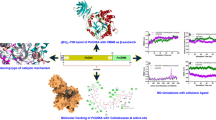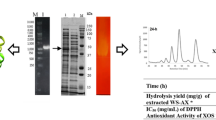Abstract
As one critical enzyme in deconstructing complicated cellulose matrix, endoglucanase (EG) is needed to exhibit high activity and thermostability under severe industrial conditions. Driven by this purpose, EGtf1 (Q08166) and EGtf2 (Q7X2N2), with relatively high specific activities, were selected out of 43 putative EG genes from SWISS-PROT database. These distinguished EGs were successfully overexpressed in Escherichia coli and purified by one-step affinity chromatography. The maximal activity was shown at approximate pH 5.0 and 50 °C. It is worth noting that EGtf1 and EGtf2 displayed outstanding thermostability with a half-life of up to 1,386 h at 50 °C, which is almost 100-fold higher than other reported EGs. Furthermore, the presence of various metal ions (1 mM) or organic solvents (50%, v/v) did not cause significant effect on the activities of EGtf1 and EGtf2 and even showed 2.1- and 2.7-fold enhancement in the case of dodecanol. All these features, especially the excellent thermostability of EGtf1 and EGtf2, enable them to become a good candidate for further protein engineering to realize the ultimate practical application in biomass industry.






Similar content being viewed by others
References
Wang, Y., Wang, X., Tang, R., Yu, S., Zheng, B., & Feng, Y. (2010). A novel thermostable cellulase from Fervidobacterium nodosum. Journal of Molecular Catalysis B Enzymatic, 66, 294–301.
Liu, S., Shibu, M. A., Jhan, H., Lo, C. T., & Peng, K. (2010). Purification and characterization of novel glucanases from Trichoderma harzianum ETS 323. Journal of Agricultural and Food Chemistry, 58, 10309–10314.
Lee, L., Paul, W., Willem, Z., & Isak, P. (2002). Micobial cellulase utilization: fundametals and biotechnology. Microbiology and Molecular Biology Reviews, 66, 506–577.
Priit, V., Sild, V., Pettersson, G., & Johansson, G. (1998). The initial kinetics of hydrolysis by cellobiohydrolases I and II is consistent with a cellulose surface - erosion model. European Journal of Biochemistry, 253, 469–475.
Palonen, H., Tjerneld, F., Zacchi, G., & Tenkanen, M. (2004). Adsorption of Trichoderma reesei CBHI and EG II and their catalytic domains on steam pretreated softwood and isolated lignin. Journal of Biotechnology, 107, 65–72.
Várnai, A., Viikari, L., Marjamaa, K., & Siika-aho, M. (2010). Adsorption of monocomponent enzymes in enzyme mixture analyzed quantitatively during hydrolysis of lignocellulose substrates. Bioresource Technology. doi:10.1016/j.biortech.2010.07.120.
Watanabe, H., Nakamura, M., Tokuda, G., Yamaoka, I., Scrivener, A. M., & Noda, H. (1997). Site of secretion and properties of endogenous endo-β-1,4-glucanase components from Reticulitermes speratus (Kolbe), a Japanese subterranean termite. Insect Biochemistry and Molecular Biology, 27, 305–3139.
Tokuda, G., Watanabe, H., Matsumoto, T., & Noda, H. (1997). Cellulose digestion in the wood-eating higher termite, Nasutitermes takasagoensis (Shiraki): distribution of cellulases and properties of endo-β-1,4-gIucanase. Zoological Science, 14, 83–93.
Okada, G., & Nishizawa, K. (1975). Enzymatic studies on a cellulase system of Trichoderma viride III. Transglycosylation properties of two cellulase components of random type. Journal of Biochemistry, 78, 297–306.
Okada, G. (1976). Enzymatic studies on a cellulase system of Trichoderma viride. IV. Purification and properties of a less-random type cellulase. Journal of Biochemistry, 80, 913–922.
Kwon, I., Ekino, K., Goto, M., & Furukawa, K. (1999). Heterologous expression and characterization of endoglucanase I (EGI) from Trichoderma viride HK-75. Bioscience, Biotechnology, and Biochemistry, 63, 1714–1720.
Nazir, A., Soni, R., Saini, H. S., Manhas, R. K., & Chadha, B. S. (2009). Purification and characterization of an endoglucanase from Aspergillus terreus highly active against barley β-glucan and xyloglucan. World Journal of Microbiology and Biotechnology, 25, 1189–1197.
Mamma, D., Hatzinikolaou, D., Kekos, D., Stamatis, H., & Kalogeris, E. (2009). Adsorption of major endoglucanases from Thermoascus aurantiacus on cellulosic substrates. World Journal of Microbiology and Biotechnology, 25, 781–788.
Dong, J., Hong, Y., Shao, Z., & Liu, Z. (2010). Molecular cloning, purification, and characterization of a novel, acidic, pH-stable endoglucanase from Martelella mediterranea. Journal of Microbiology, 48, 393–398.
Shibuya, H., & Kikuchi, T. (2008). Purification and characterization of recombinant endoglucanases from the pine wood nematode Bursaphelenchus xylophilus. Bioscience, Biotechnology, and Biochemistry, 72, 1325–1332.
Beldman, G., Voragen, A. G. J., Rombouts, F. M., Searle-van Leeuwen, M. F., & Plinik, W. (1987). Adsorption and kinetic behavior of purified endoglucanases and exoglucanases from Trichoderma viride. Biotechnology and Bioengineering, 30, 251–257.
Medve, J., Stahlberg, J., & Tjerneld, F. (1997). Isotherms for adsorption of cellobiohydrolase I and II from Trichoderma reesei on microcrystalline cellulose. Applied Biochemistry and Biotechnology, 66, 39–56.
Zhang, Y. H. P., & Lynd, L. R. (2004). Toward an aggregated understanding of enzymatic hydrolysis of cellulose: noncomplexed cellulase systems. Biotechnology and Bioengineering, 88, 797–824.
Ma, A., Hu, Q., Qu, Y., Bai, Z., Liu, W., & Zhuang, G. (2008). The enzymatic hydrolysis rate of cellulose decreases with irreversible adsorption of cellobiohydrolase I. Enzyme and Microbial Technology, 42, 543–547.
Yi, Z. L., Pei X. Q., & Wu Z. L. (2011). Introduction of glycine and proline residues onto protein surface increases the thermostability of endoglucanase CelA from Clostridium thermocellum. Bioresource Technology, 102, 3636–3638.
de Castro A. M,. de Albuquerque de Carvalho M. L., Leite S. G. F., Pereira N. (2009). Cellulases from Penicillium funiculosum: production, properties and application to cellulose hydrolysis. Journal of Industrial Microbiology and Biotechnology, 37, 151-158.
Wang C. Y., Hsieh Y. R., Chan H., Lin H. T., Tzeng W. S., Shyu Y. T. (2009). Purification and characterization of a novel halostable cellulase from Salinivibrio sp. strain NTU-05. Enzyme and Microbial Technology, 44, 373-379.
Qin Y. Q., Wei X. M., Liu X. M., Wang T. H., Qu Y. B. (2008). Purification and characterization of recombinant endoglucanase of Trichoderma reesei expressed in Saccharomyces cerevisiae with higher glycosylation and stability. Protein Expression and Purification, 58, 162-167.
Lu M., Li D. H., Zhang C. H. (2002). Purification and properties of an endocellulase from the thermophilic fungus Chaetomium thermophile. ATCA Microbiologica Sinia, 42(4), 472-477.
Bothwell M. K., Daughhetee S. D., Chaua G. Y., Wilson D. B., Walker L. P. (1997). Binding capacities for Thermomonospora fusca E3, E4, and E5, the E3 binding domain, and Trichoderma reesei CBHI on Avicel and bacterial microcrystalline cellulose. Bioresource Technology, 60, 169–178.
Krogh K. B. R. M., Kastberg H., Jorgensen C. I., Berlin A., Harris P. V., Olsson L. (2009). Cloning of a GH5 endoglucanase from genus Penicillium and its binding to different lignins. Enzyme and Microbial Technology, 44, 359-367.
Acknowledgements
This work was financially supported by the National Natural Science Foundation of China (No. 31071604), Ministry of Science and Technology, P. R. China (Nos. 2011CB710800), and China National Special Fund for State Key Laboratory of Bioreactor Engineering (No. 2060204).
Author information
Authors and Affiliations
Corresponding authors
Electronic supplementary material
Below is the link to the electronic supplementary material.
ESM 1
(DOC 563 kb)
Rights and permissions
About this article
Cite this article
Qiu, LH., Li, CX., Sun, J. et al. Thermostable Bacterial Endoglucanases Mined from Swiss-Prot Database. Appl Biochem Biotechnol 165, 1473–1484 (2011). https://doi.org/10.1007/s12010-011-9368-y
Received:
Accepted:
Published:
Issue Date:
DOI: https://doi.org/10.1007/s12010-011-9368-y




